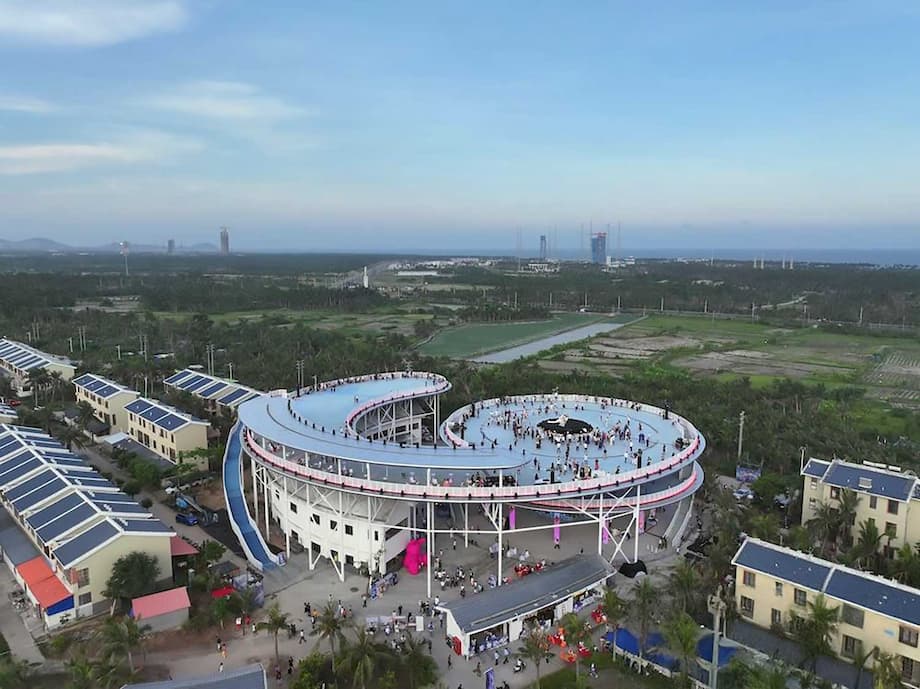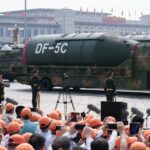A new kind of island getaway
On a tropical coast better known for coconut groves and long beaches, crowds now gather with tripods and telephoto lenses. Hainan, China’s southern island province, has become a place where a beach day can end with a rocket roaring into the night. The city of Wenchang, on the island’s northeast, hosts China’s only coastal launch site that handles the country’s largest rockets. Visitors line the shore for a clear view across water to the launch towers. When engines ignite, light floods the sky and a rolling shock catches in the chest. For many travelers, it is a life list moment wrapped inside a seaside vacation.
- A new kind of island getaway
- Why Wenchang draws launch watchers
- How to see a launch, and what to expect
- The tourism buildout around the spaceport
- Education and the family draw
- From beaches to moonshots, what to do beyond a launch
- Beyond viewing, toward suborbital rides
- Practical tips for launch travelers
- Challenges as the scene scales up
- Key Points
Launch watching has shifted from a novelty to a mainstream attraction. Travelers swap tips on forums, families arrive with children for science study tours, and hotels tailor experiences around liftoff days. One traveler’s account from a recent trip captures how plans come together around a moving target. Launch dates can remain unannounced until late in the countdown, so enthusiasts watch for subtle cues. In Wenchang, a spike in bookings at the Hilton Wenchang, popular with launch crews and fans, often signals that a window is near. On the day, local police close key roads near Longlou township, crowds funnel to designated areas, and hotel lawns and nearby beaches turn into impromptu grandstands. When the final seconds tick away and the vehicle clears the tower, the spectacle feels both precise and primal.
Why Wenchang draws launch watchers
China opened the Wenchang Space Launch Site in 2016 to handle heavy rockets such as Long March 5 and medium rockets such as Long March 7. The coastal location, close to the equator, gives rockets a velocity boost from Earth’s rotation. Engineers use that extra push to carry heavier payloads. Space analysts say a launch from low latitude can add roughly 10 to 15 percent to payload capacity compared with an inland site at higher latitude. The seaside setting also simplifies logistics for oversized rocket stages that arrive by ship.
The setting blends cutting edge engineering with public access. A public beach sits near the pads, and hotels, including the Hilton Wenchang, promote viewing spots. Around town, rocket motifs show up on light poles and souvenir stands. The mix has given Wenchang a reputation as China’s Cape Canaveral, a place where spaceflight shapes calendars and dinner plans.
The boom is measurable. Local figures point to 1.5 million visitors to Wenchang and nearby Longlou over roughly two years, an extraordinary surge for a town of fewer than 30,000 residents. During marquee missions such as the Change 6 lunar sample return from the far side of the moon, crowds near the site swelled to tens of thousands in a single day. Hotel capacity has ballooned from a handful of properties to more than 50, and rates during launch windows can climb severalfold. For many Chinese visitors, the trips blend national pride with a family outing. For international travelers, the scene offers rare proximity to a major launch site.
How to see a launch, and what to expect
Launch timing remains dynamic until late in the process. China does not always release public countdowns far in advance. Enthusiasts often track airspace and maritime closure notices, follow official accounts, and watch for local signals such as road signboards or activity at the hotels closest to the pads. Once a likely window appears, many travelers book flexible rates and aim for a stay of several days to increase the chance of catching a lift off.
On launch day, traffic builds quickly on the narrow roads east of Longlou. Police establish checkpoints and seal off certain routes for safety. Only vehicles with permits can cross the last stretch to beachfront hotels. Many viewers park farther away and walk or take shuttle services arranged by tourism operators. The public beach areas provide a direct line of sight to the towers, and hotels advertise lawn and terrace access for guests. Arrive early, since the most popular spots fill hours before ignition, especially for heavy rockets such as Long March 5.
To address crowding and improve safety, Wenchang opened a purpose built viewing site in May 2025, the Yaoguang Rocket Launch Viewing Platform in Dongjiao. The complex can hold more than 2,000 people and includes exhibits, shops, and eateries that turn the wait into a hands on learning experience. Interactive displays, from holographic sky domes to a time capsule project, aim at families and students. The platform brings order to a scene that previously leaned on beaches, rooftops, and ad hoc terraces.
Science outreach has grown alongside viewing options. The Wenchang Aerospace Science Popularization Center runs launch day events with guest speakers and kid friendly activities. During the Change 6 campaign, the area drew crowds of young journalists and school groups who paired a beach holiday with a four day space study tour. The format is simple. Spend the day learning about rocket history and orbit basics, then cap it with a live demonstration in the sky.
The tourism buildout around the spaceport
Wenchang sits inside the Hainan Free Trade Port, a provincial strategy that pairs open economic policies with targeted industries. The city’s project, the Wenchang International Aerospace City, links the launch area to a growing high tech zone and a tourism zone. By early 2025, local officials reported that more than 700 space related firms had set up in the area, including satellite makers and data companies. As commercial launch providers expand operations, local planners speak of a cadence that could reach a liftoff every couple of weeks.
Tourism numbers reflect the shift. Longlou now counts dozens of guesthouses and small hotels, and local homestay owners have expanded capacity to match launch crowds. In one recent year, Wenchang tallied more than 300,000 visitors, with tourism revenue topping 100 million yuan. Incomes have risen across the town as more residents find work in hospitality, retail, and support services. Stores sell rocket shaped toys and bottled water, cafes serve lift off pastries, and night markets add space themed lighting to lure families after sunset.
New attractions continue to arrive. In Haikou, Hainan’s capital, a major science museum with interactive galleries is preparing to open to the public. Wenchang’s plans include a large space museum, a space theme park, and even a sea based viewing platform for offshore perspectives during coastal launches. The Wenchang Aerospace Supercomputing Center has begun trials with digital exhibition halls, and the Hainan Aerospace Engineering Breeding Research Center has opened tours that showcase plants grown from seeds exposed to spaceflight conditions. The aim is to lengthen visitor stays beyond a single night and turn launch watching into a full weekend of science, culture, and food.
Education and the family draw
Space in Wenchang is not only a spectacle, it is a syllabus. School groups book holiday sessions that blend classroom time with guided visits to museums and the viewing platform. During the Change 6 launch window, educators from Guangxi brought hundreds of elementary students and parents for a four day program. Families said they wanted children to see a real launch, ask questions about life aboard China’s Tiangong space station, and connect classroom physics to a thunderous event they can feel.
Local creators have built small businesses around the scene. Photographers sell postcards and calendars featuring night launches reflected in the surf. Vendors move racks of mission patches. Even long time watchers still describe a sense of awe after dozens of launches. The repetition does not dull the raw power of ignition or the bright curve as a vehicle pitches downrange over the South China Sea.
From beaches to moonshots, what to do beyond a launch
Hainan remains a beach holiday at heart, and many visitors spend the days before or after a launch exploring the island. In Haikou, Qilou Old Street runs through a district of arcaded buildings with a blend of southern Chinese and colonial era styles. Coffee shops and noodle stalls sit under shaded colonnades, a welcome break from tropical sun. Farther south, Sanya offers high rise resorts, bay beaches, and dive boats. Seasonal festivals, including a summer island carnival with water sports shows and night performances, boost the calendar from August through peak season.
Food is part of the story. Wenchang chicken, the local breed poached and served with fragrant rice and sauces, is the origin of the famous Hainanese chicken rice found across Southeast Asia. Many travelers make a point of trying it in Wenchang itself, then compare it with their favorite version back home. Seafood stands along the coast serve fresh catches grilled over charcoal, and night markets run late when a launch brings visitors into town.
For international travelers, entry has become easier. Hainan offers visa free access for residents of more than 50 countries when itineraries meet rules on length of stay and lodging. That policy widens the pool of potential visitors who might add a launch to a beach trip. Connections from Southeast Asia are frequent. A flight from Kuala Lumpur to Haikou or Sanya takes a little over three hours, and a high speed rail line girds most of the island to reach smaller towns.
Beyond viewing, toward suborbital rides
China’s commercial sector is working to carry paying passengers to the edge of space. The firm CAS Space has announced plans to fly a suborbital vehicle with seven seats after initial tests in 2027, targeting tourist rides in 2028. The planned cabin features four large windows, and the company has floated a launch interval of roughly every 100 hours using a fleet of vehicles at an aerospace theme park in Hainan. Tickets are expected to cost between 2 million and 3 million yuan per person, placing the experience in the same price tier as early flights by Blue Origin in the United States. The timeline will depend on testing, safety reviews, and licensing, yet the signal is clear. Companies see Hainan as the place where a viewing trip may one day include a seatbelt and a microgravity arc.
Suborbital rides differ from orbital missions that carry satellites or ferry cargo to Tiangong. A suborbital flight gives passengers a high altitude climb, several minutes of microgravity, and a view of Earth’s curvature before the vehicle returns to the launch region. Training focuses on safety procedures and short bouts of high acceleration during ascent and reentry. If Hainan becomes a regular host to such flights, the island’s tourism economy will gain a new product tier that sits alongside rockets streaking to orbit.
Practical tips for launch travelers
Planning around a moving target is easier with a few ground rules and a flexible mindset. These tips reflect recent visitor experiences in Wenchang and Hainan.
- Track activity in the week before a possible window. Watch official announcements and local transport notices for road or sea closures.
- Book lodging with flexible cancellation. Rooms near Longlou and Dongjiao fill fast and rates jump during launch periods.
- Arrive early on launch day. Walking in from public lots can take 30 to 60 minutes once roads close. Bring water, sun protection, and a small flashlight for night launches.
- Pick a viewing style. The public beach is free but crowded. Hotel terraces offer amenities for guests. The Yaoguang viewing platform combines comfort with exhibits and clear sightlines.
- Mind safety zones and local instructions. Stay behind barriers, keep drones grounded unless approved, and use ear protection if you are close to the waterline.
- Prepare for weather. Summer brings heat and pop up storms. Winter is cooler and drier. Launches can scrub for wind or technical checks, so leave margin in your schedule.
- Payments and transport. Mobile payments are common, and major apps now support foreign bank cards. High speed rail links Haikou, Qionghai, and Sanya, and taxis or ride hailing cover the last leg to Longlou and Dongjiao.
- Combine with other sights. If a launch slips, spend a day at the Haikou museums, wander Qilou Old Street, or head south to Sanya’s beaches.
Challenges as the scene scales up
Success brings pressure on roads, beaches, and shorelines. Launch days can create big traffic jams, so planners are pushing more structured viewing areas and shuttle options. Coastal sites must balance visitor access with safety zones and environmental protection. A steady launch rhythm also asks more of local services, from crowd control and sanitation to emergency medical teams. Officials in Hainan say new infrastructure, clear public information, and more varied attractions can spread crowds across time and space, reducing stress on a single beach or tower view.
Key Points
- Wenchang on Hainan Island has become China’s leading public friendly launch site, with beach viewing and hotel terraces drawing large crowds.
- The low latitude coastal location boosts rocket performance and allows large rockets such as Long March 5 to reach orbit with heavier payloads.
- Tourism is booming, with more than 1.5 million visitors to the Wenchang and Longlou area over two years and major hotel growth.
- A new purpose built Yaoguang viewing platform opened in 2025, adding capacity, exhibits, and services for spectators.
- Launch days bring road closures near Longlou, so travelers often park farther out and walk or use shuttles to viewing zones.
- Wenchang International Aerospace City reports more than 700 space related firms and plans for museums, a theme park, and a sea based viewing platform.
- Families and school groups now plan space study tours around major missions such as Change 6.
- Beyond launches, Hainan offers Haikou’s Qilou Old Street, Sanya’s beaches, and island festivals that fill the summer calendar.
- Visa free entry for residents of more than 50 countries and fast flights from Southeast Asia make trips easier to plan.
- CAS Space aims to start suborbital tourist flights from Hainan around 2028, with ticket prices in the millions of yuan.




